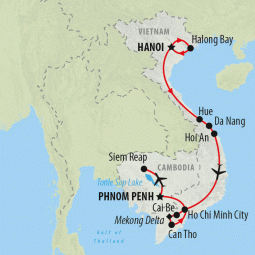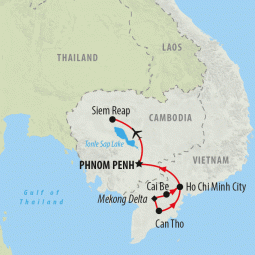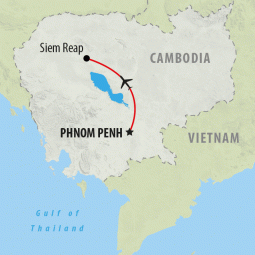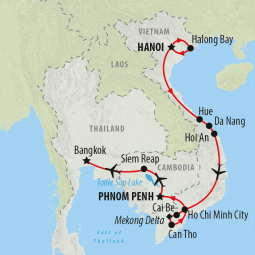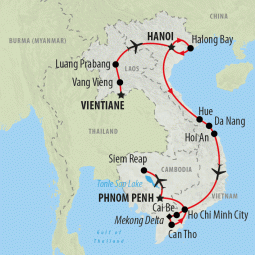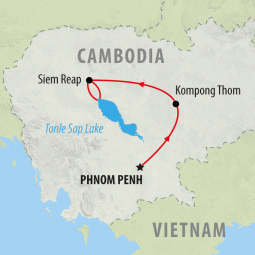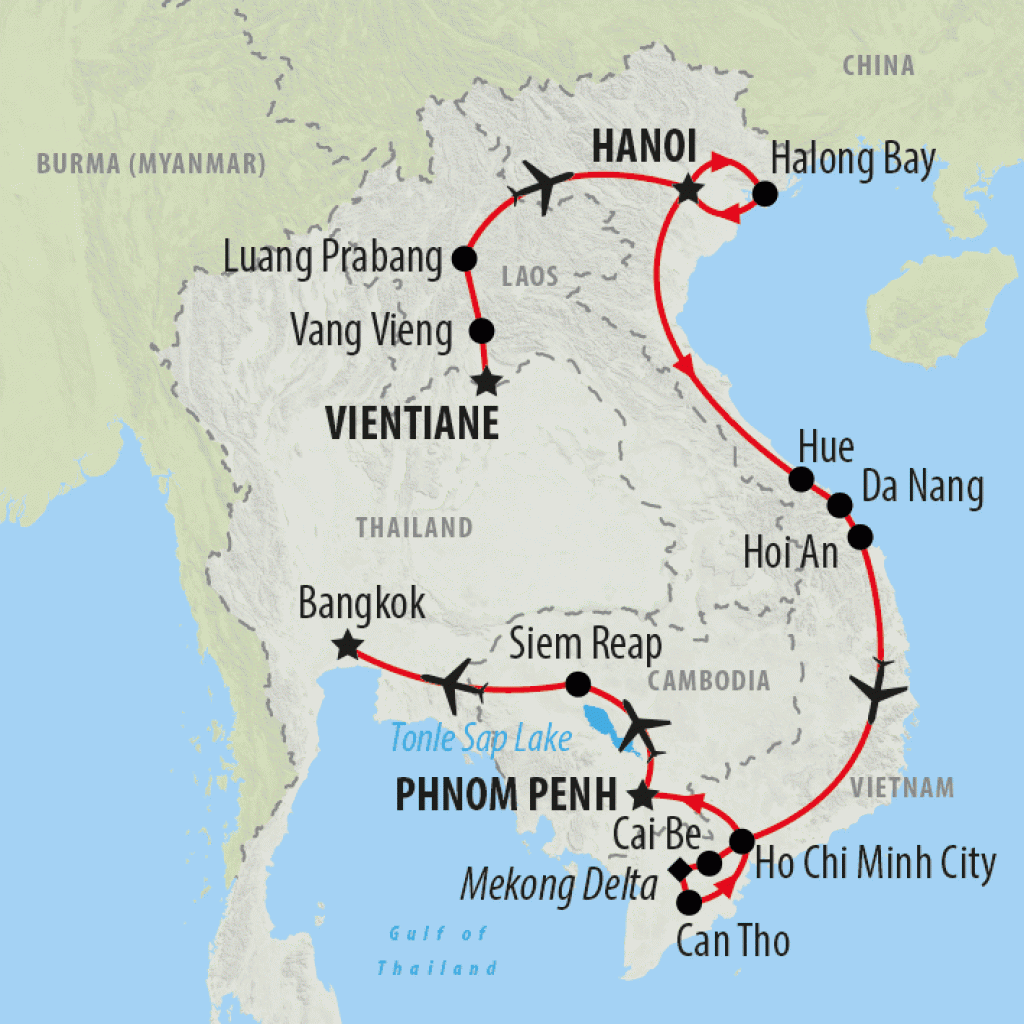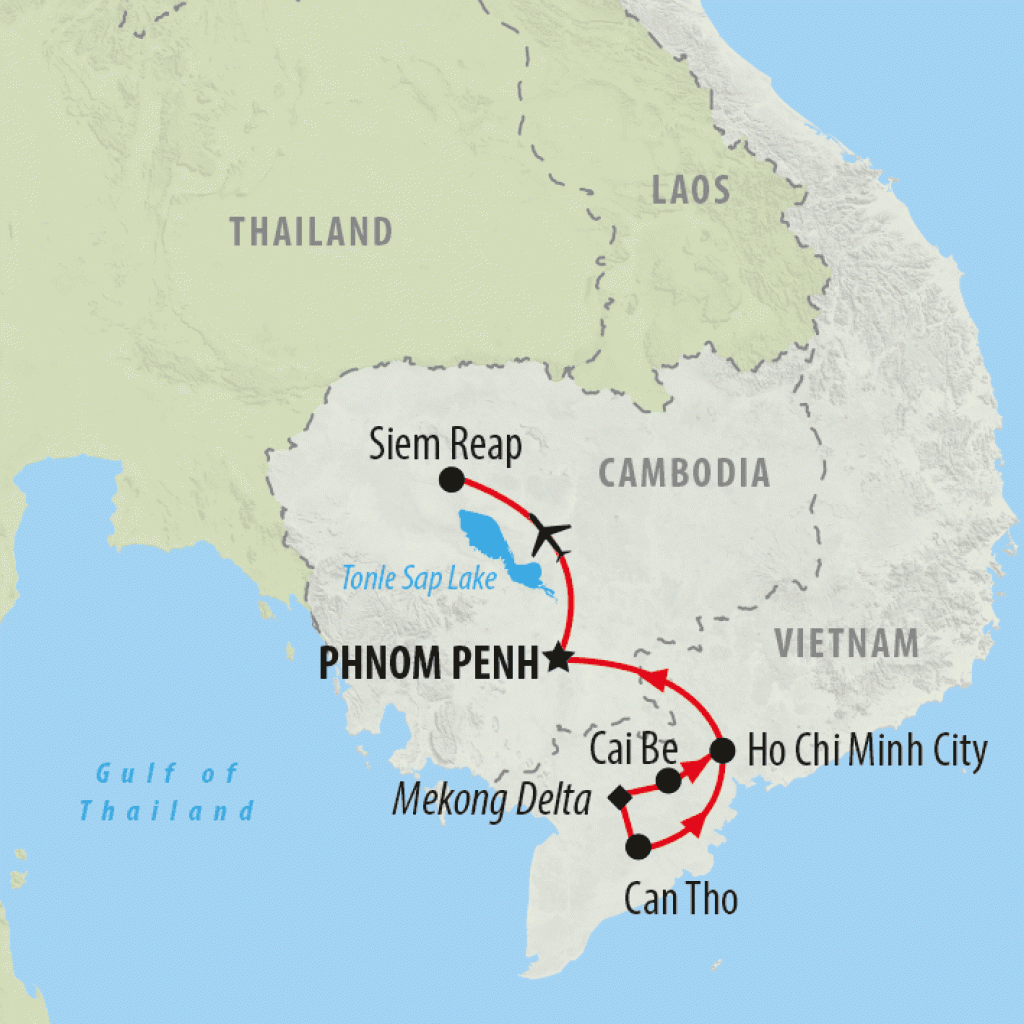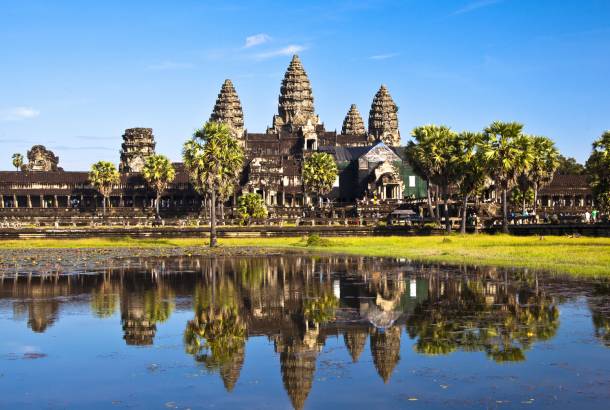
1. Angkor Wat
Representing the abode of Hinduism's ancient gods, the spectacular temple of Angkor Wat is quite literally heaven on earth and the jewel in the Khmer archaeological crown. It's the largest of all Angkor's temples and one of the best preserved. Surrounded by a huge rectangular reservoir and an outer wall measuring over 3km in length, the temple consists of three tiered galleries and five towers shaped like lotus buds.
Such is the national pride in the site that the outline of the temple features on Cambodia's national flag. Little can prepare you for the sheer scale, splendour and symmetry of Angkor Wat, a perfect blend of artistic genius and spiritual devotion. Although somewhat neglected after the 16th century, Angkor Wat is unique in that it was never completely abandoned and the moat safeguarded the temple against the encroaching jungle.
Aside from its size and remarkable condition, Angkor Wat is also famous for its extensive decoration, specifically its bas-reliefs. The inner walls of the outer gallery feature a series of large-scale stone carvings depicting lively scenes from the Hindu epics the Ramayana and the Mahabharata. Numerous pillars and walls are also decorated with exquisite depictions of apsaras (heavenly nymphs) and devata (Hindu deities).
Thousands of these figures are carved throughout Angkor Wat, each one unique with different poses and even different hairstyles. With so much to see, we recommend allowing yourself at the very least 2 hours to explore Angkor Wat although half a day will provide a more leisurely experience.
Thinking of visiting Cambodia? Download a copy of our Worldwide brochure for inspiration.
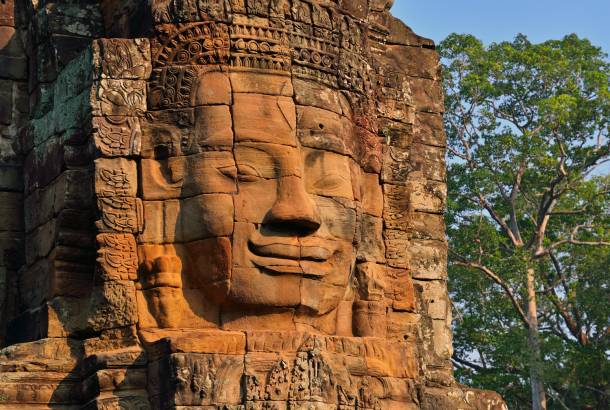
2. Bayon
One of the most iconic temples in Angkor is Bayon where a sea of colossal stone faces serenely smile down from 54 gothic towers that rise out from the upper terrace. It's believed the faces are a representation of Avalokitesvara, the bodhisattva of compassion, though their striking resemblance to King Jayavarman VII has led many scholars to believe that the king considered himself a devaraja (god-king) within the context of Buddhism.
When walking around the temple at least a dozen stone heads will be in view at any given moment, poised profiles contrasted against full faces featuring curving lips and almond-shaped eyes. Placed at varying heights on the towers, the smiling faces peer down at you from every angle inspiring awe and compliance, though as you ascend the temple's three levels meet these same faces meet you eye-to-eye and appear more magnanimous.
With no outer wall or moat to enclose the complex, Bayon stands in dense jungle and it was some time before researchers discovered that its location marks the centre of the city of Angkor Thom with roads leading directly to the temple from the city gates. Due to its eastward orientation, Bayon is best seen in the early morning when the soft, growing light of day slowly illuminates face after face. Late afternoon is an equally good time to visit when the same happens in reverse, each face gradually fading into shadow.
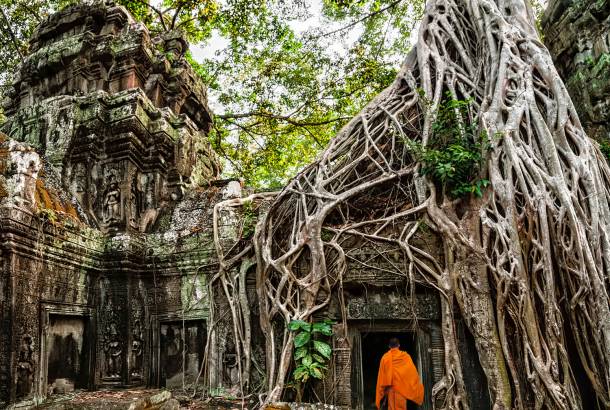
3. Ta Prohm
Undoubtedly the most evocative and photographic temple in all of Angkor, the Buddhist temple of Ta Prohm lies in a semi-ruined state engulfed by the jungle. The muscular roots of towering trees spill over the ramparts like the tentacles of a gigantic octopus with the leaves cloaking the temple in dappled shadow and casting a greenish hue that gives Ta Prohm an other-worldly ambience.
As towers crumble beneath the weight and walls are split in two by probing limbs, it's easy to contemplate the triumph of nature as it slowly destroys what man has created. Neither is it difficult to imagine how early explorers might have felt stumbling upon Ta Prohm in its raw and ethereal state, claimed by the earth in such spectacular fashion.
Much about Ta Prohm's history is known thanks to a Sanskrit stone inscription that details the temple's dependents and inhabitants, as well as figures on the precious stones once contained within its walls. Beneath the encroaching foliage and carpets of moss lie stone reliefs of female deities and meditating monks. Dislodged blocks of stone render many of the narrow corridors impassable and those that are navigable are largely in shadow thanks to the thick roots that fill window openings so it's advisable to bring a torch.
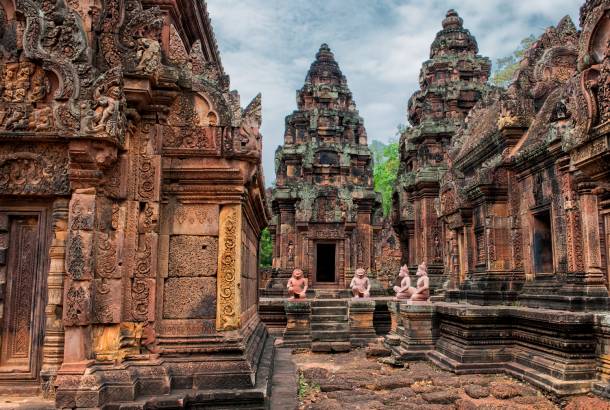
4. Banteay Srei
Considered to be the art gallery of Angkor, the small temple of Banteay Srei features some of the finest stone carvings ever seen. Built of fine grained rose-pink sandstone, the walls of the temple are ornamented with elaborate floral motifs, divine figures and breathtaking depictions of episodes from the Ramayana.
The decorative carvings cover practically every available surface of the temple from the pediments that display entire mythological scenes to the beautifully sculpted lintels. Dedicated to Shiva, this Hindu temple is amazingly well-preserved and was one of the first major temples to be restored using the anastylosis method whereby original architectural elements are used to rebuild the ruined monument or structure.
Dating back to the 10th century, Banteay Srei is the only temple in Angkor to have been commissioned by a Brahmin rather than a king. A number of scholars consider the architecture and decoration of Banteay Srei to be more influenced by Indian models. Its modern name translates as 'citadel of women' as the incredibly delicate reliefs carved into the low walls could not have been created by the hand of a man.
Located further north of Angkor Wat and roughly a 30-minute drive from Siem Reap, Banteay Srei is further out than the main temples but most definitely worth the extra travel time. The near-perfect technique used in Banteay Srei that has resulted in many three-dimensional carvings should be high priority for every visitor.
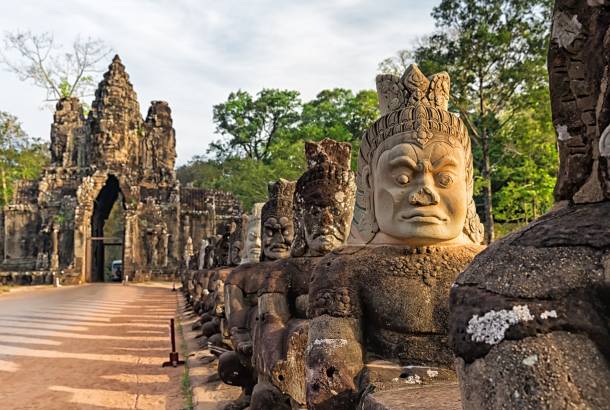
5. Angkor Thom
The monumental Angkor Thom was the last great capital of the Khmer empire which likely supported a population of one million at its zenith. Measuring more than 10 square km in size, the fortified city features eight metre high walls and a massive moat designed to keep invaders at bay from the residences of priests, and royal and military officials it encloses.
Angkor Thom's most important monuments lie within: including Bayon, the temple of Baphuon (a pyramidal representation of mythical Mt. Meru), the Royal Enclosure, Phimeanakas (a three-tiered temple that once would have been topped with a golden spire), and the Terrace of Elephants (a giant viewing stand with five piers extending towards the Central Square).
There are five entry gates to the city - one facing each cardinal direction and a second east-facing entrance known as the Victory Gate. Overlooking the portals are large towers topped with four huge faces, reminiscent of the stone heads at Bayon temple, pointing in all directions. The best way to approach Angkor Thom is via the south gate along the causeway that is flanked by 54 larger than life gods and an equal number of demons.
Neatly lined in a row engaged in an epic tug of war, the monumental statues represent 'The Churning of the Ocean Milk', a popular Hindu legend which explains the origin of the drink of immortality. It's a scene depicted in a number of other Angkor temples including Angkor Wat as a bas-relief.
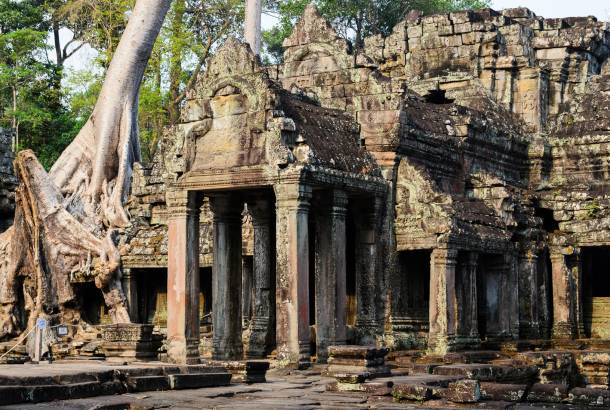
6. Preah Khan
Largely unrestored though reasonably preserved, Preah Khan is the ultimate fusion temple operating as both a Buddhist and Hindu place of worship. Concentric rectangular galleries enclose a Buddhist sanctuary with a number of Hindu satellite temples and the whole site is surrounded by a moat with the main entrance to the east.
It's one of Angkor's largest temples covering an area of 56 hectares with four ceremonial walkways leading to the temple gates and a maze of vaulted corridors and towered enclosures. Floral patterns of lichen clad the stonework along with fine carvings of apsara and bird-like creatures holding scared snakes. With massive trees growing among the ruins it bears some resemblance to Ta Prohm though with slightly fewer visitors.
Inscriptions found at the temple reveal that it was built on the site of king Jayavarman VII's victory over the invading Chams in the 12th century and fittingly the modern name of Preah Khan means 'holy sword'. It was most likely where the king temporarily resided whilst he waited for Angkor Thom to be built. Serving as an important centre for worship and learning, Preah Khan was dedicated to hundreds of deities and 18 major festivals were held at the temple complex each year, which demanded a team of thousands of attendants, servants and performers.
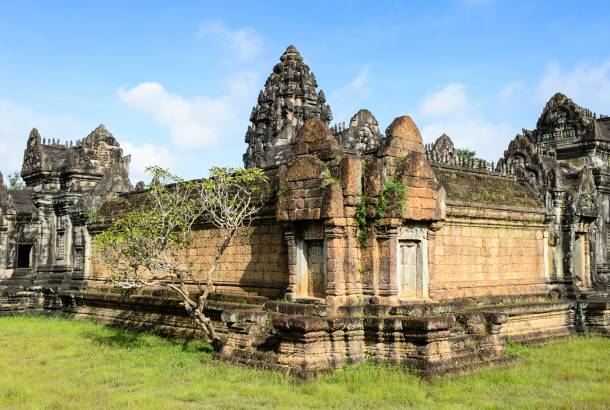
7. Banteay Samre
Thanks to extensive restoration work, the temple of Banteay Samre is in an excellent state of repair with elaborate architecture and fine carvings of Hindu and Buddha depictions. Built in the same period as Angkor Wat, the temple displays a number of similar features including the style of its towers and balustrades.
As one of the smaller temples in the archaeological complex, it may not rival the magnificence of Angkor Wat or match the evocative atmosphere of Ta Prohm but its compact inner enclosure is a beguiling web of ornate doorways and large windows set within a geometry of the detailed walls, tiered walkways and a unique inner moat (now dry).
Due to its location further out from the main temples, Banteay Samre receives far fewer visitors and its peaceful setting provides the chance to absorb the sheer splendour of the Khmer Empire and the city of Angkor. In terms of location, Banteay Samre can easily be combined with a visit to Banteay Srei.
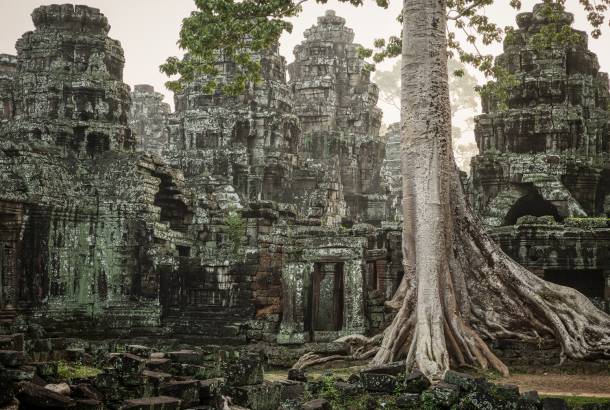
8. Banteay Kdei
Dating back to the 12th century, the large Buddhist monastery of Banteay Kdei was built in the same period as Ta Prohm conforming to a similar style with four concentric walls that enclose the central sanctuary and four entrances decorated with garudas. Known as the 'citadel of chambers', the temple is a treasure chest of sculptures and impressive bas-reliefs of apsaras and dancing girls. Built from a variety of stone materials, the temple complex displays a range of colours from warm peach tones to grey surfaces given a slight greenish hue by years of weathering.
After several centuries of neglect and vandalism, Banteay Kdei has been left in a ruinous state and is considerably less busy than its neighbours, which alone makes it worth a visit. Built on a single level with tightly packed architectural structures, the temple can easily be explored in under an hour and can be combined with a quick visit to Sra Srang - the Pool of Ablutions, once reserved for the king and his consorts. Measuring 800x400m, it's a surprisingly attractive body of water and a popular site to watch the sunrise.
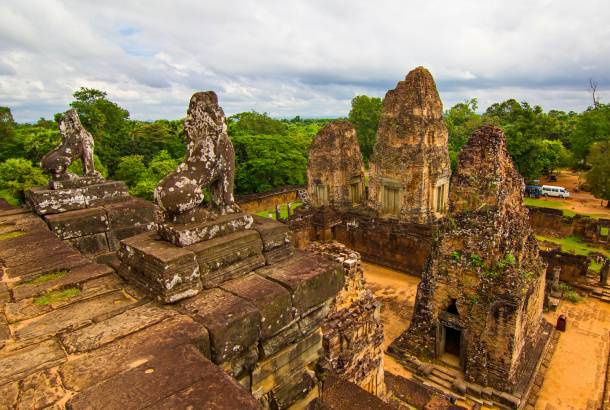
9. Pre Rup
Reminiscent of a miniature Angkor Wat with its five lotus towers, the temple of Pre Rup was built in 961 by Rajendravarman II as the state temple of the king. Translating as 'turning the body', Pre Rup has been associated with funerary rituals as it refers to a cremation method of tracing a corpse's outline in ashes.
Dedicated to Shiva, the temple consists of a three-tiered pyramid-shaped temple mountain and would have once been covered with intricate carvings. Built from less durable grey sandstone, over time the temple walls have slowly eroded in the wind and rain, however, there are still some surprisingly detailed lintel carvings on the south-western tower. To stop further collapse, some of the outermost eastern towers are propped up by wooden supports.
Pre Rup may not be in the best of conditions but its large lion statues, crumbling charm and magnificent size and structure warrant at least 30 minutes of your time. It also affords impressive views looking out towards Phnom Bok in the east and the towers of Angkor Wat in the far west. The site is especially picturesque at sunset when the dying light causes the warm tones of the brick and laterite to softly glow.
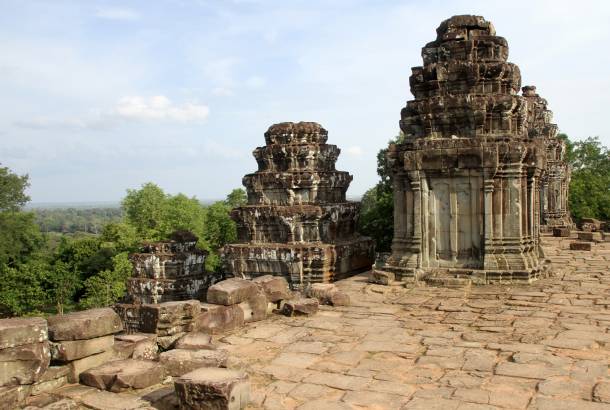
10. Phnom Bakheng
Built more than two centuries before Angkor Wat, Phnom Bakheng lays claim as the first of the mountain temples constructed in the Angkor region. It was once the architectural centrepiece of Yasodharapura, the second capital city of the Khmer Empire, and is testimony to the power of symmetry.
The temples feature five tiers with seven levels in all when you include the base and the summit. Four towers stand at the cardinal points on the summit of the temple with a central sanctuary to create a layout that represents Mt. Meru, a portrayal given further weight by the temples location atop a 65m-high hill that rises steeply from the surrounding plain.
Many visitors time their visit to Phnom Bakheng with sunset for the remarkable views out over Angkor Wat. Despite a distance of 1.3km, it's possible to see the five towers of Angkor Wat as they fall into the gloom of the jungle as the light fades. It's one of the most popular vantage points for sunset, for good reason, and attracts large groups of visitors.
Our Angkor Tours
We visit the Angkor Temple Complex on all of our group tours journeying through Cambodia. Alternatively, we can put together your own unique itinerary combining Angkor with more of Cambodia's top sights as a tailor-made holiday.
